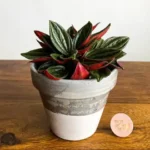Meet Alocasia macrorrhizos: The Giant of the Tropics
Alocasia macrorrhizos, also known as Giant Taro, Elephant Ear, or simply Giant Alocasia, is a breathtaking tropical plant beloved for its striking foliage and dramatic size. With leaves as large as elephant ears—hence the nickname—it’s a statement piece for any indoor jungle or shaded corner of the garden. Native to Southeast Asia and the Pacific Islands, this plant thrives in warm environments and is a favorite among foliage enthusiasts seeking a bold, architectural presence.
Understanding the Characteristics
This species of Alocasia can grow incredibly large, with mature leaves reaching up to 3 feet long and the plant itself standing several feet tall under ideal conditions. Its broad, arrow-shaped leaves are shiny and rich green, with deep veins that add texture and definition.
Despite its size and tropical origin, Alocasia macrorrhizos can be adapted to indoor environments if given the right care. However, this isn’t your average coffee-table plant—its impressive size means it will require space, both vertically and laterally.
Light Requirements
Alocasia macrorrhizos thrives in bright, indirect sunlight. In its native habitat, it grows under the partial canopy of taller trees, making dappled light ideal. Direct sunlight can scorch the leaves, while insufficient light may result in slow growth and smaller, pale leaves.
Tips for Optimal Lighting:
- Place your plant near an east- or north-facing window, or filter direct sunlight with sheer curtains.
- A grow light can supplement natural lighting, especially in winter months or darker rooms.
- Rotate the plant every few weeks to promote even growth on all sides.
Watering and Humidity
Alocasia macrorrhizos prefers a consistent watering routine, but it’s essential not to overdo it. The roots are susceptible to rot if left in soggy soil. Allow the top 2-3 inches of soil to dry out between waterings.
Watering Guidelines:
- Water thoroughly, then let excess water drain out completely.
- Reduce watering frequency during the plant’s dormant period (late fall to early spring).
- Mist the leaves regularly, especially during dry months or if you live in an arid climate.
This tropical plant loves high humidity—ideally 60% or more. Indoor humidity can often fall short of this, especially when heating or air conditioning systems are running.
Humidity-Boosting Tips:
- Use a room humidifier nearby.
- Place the plant on a pebble tray filled with water (make sure the pot isn’t sitting directly in water).
- Group plants together to create a more humid microclimate.
Soil and Potting Mix
When it comes to soil, Alocasia macrorrhizos needs a loose, well-draining mix. A compact or overly moist substrate can cause root rot or fungal problems.
Ideal Soil Composition:
- 1 part peat moss or coco coir for moisture retention
- 1 part perlite for improved aeration
- 1 part pine bark or orchid bark for structure and drainage
Make sure your pot has drainage holes to prevent standing water. You may also want to select a heavier container to help anchor the plant, as its large leaves can make it top-heavy.
Feeding and Fertilizing
This fast-growing tropical plant benefits from regular feeding during the growing season. A balanced liquid fertilizer diluted to half strength works well when applied every 2–4 weeks in spring and summer.
Fertilization Tips:
- Use a fertilizer with equal parts nitrogen, phosphorus, and potassium (e.g., 10-10-10).
- Refrain from fertilizing in winter when growth slows significantly.
- Watch for salt buildup or leaf tips turning brown—these can be signs of over-fertilization.
Repotting and Pruning
Repotting is typically required every 1–2 years or when the plant outgrows its container. Signs include visible roots emerging from drainage holes, compacted soil, or stunted growth.
Repotting Tips:
- Choose a pot one size larger to accommodate root expansion.
- Refresh the soil mix to ensure continued drainage and nutrient availability.
- Spring is the ideal time to repot, just as the growing season begins.
This plant rarely needs pruning, aside from removing yellow or damaged leaves to maintain overall appearance and plant health. Always use clean, sharp shears or scissors during trimming to avoid infection.
Common Problems and Solutions
Despite its dramatic looks, Alocasia macrorrhizos is relatively easy to care for with the proper knowledge. Be on the lookout for these common issues:
Pests:
- Spider Mites: Fine webbing and speckled yellow leaves may signal an infestation. Try washing the plant and applying neem oil.
- Mealybugs: Look for white, cottony clumps in leaf axils. Remove with cotton swabs dipped in alcohol.
- Aphids or Scale: Insecticidal soap or repeated washing can help control outbreaks.
Diseases:
- Root Rot: Typically results from overwatering. Ensure soil and pot provide adequate drainage.
- Leaf Spot: Fungal spots or yellow patches may benefit from better air circulation and reduced leaf wetness.
Is Alocasia macrorrhizos Toxic?
Yes, like many members of the Araceae family, Alocasia macrorrhizos contains calcium oxalate crystals, which can be toxic if ingested by humans or pets. Symptoms may include irritation of the mouth, tongue swelling, or digestive upset.
Safety Tips:
- Keep the plant out of reach of small children or curious pets.
- Wash hands after handling or pruning the plant, especially if sap is exposed.
Winter Dormancy and Seasonal Care
When temperatures drop or daylight decreases, your Alocasia may enter a period of dormancy. This is natural and not a cause for concern. Leaves may yellow and die back entirely.
What to Do During Dormancy:
- Reduce watering and stop fertilizing until new growth resumes in spring.
- Keep the plant in a warm, bright spot, avoiding cold drafts or windowsills.
- Resume normal care once new shoots appear in late winter or early spring.
Conclusion: A Bold Beauty for the Green-Thumbed
If you’re looking to elevate your indoor plant collection with something truly awe-inspiring, Alocasia macrorrhizos is a spectacular choice. With its giant, glossy leaves and extravagant presence, it brings a touch of the tropics into your home or greenhouse. Though its dramatic flair might seem intimidating, this plant is surprisingly manageable once you understand its needs. By providing the right balance of light, moisture, soil, and attention, you’re well on your way to growing a healthy and thriving Giant Alocasia. Whether you’re a beginner or seasoned indoor gardener, this plant makes an unforgettable addition to your leafy collection.
References
- Anderson, N. O. (2006). Flower breeding and genetics: Issues, challenges and opportunities for the 21st century. Springer Science & Business Media.
- Bouman, L. W. (2012). Alocasia Species Overview. In The World Checklist of Selected Plant Families. Royal Botanic Gardens, Kew.
- Fessenden, R. J. (2019). Houseplants: The Complete Guide to Choosing, Growing, and Caring for Indoor Plants. DK Publishing.








